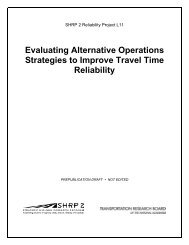Contemporary Approaches to Parking Pricing: - FHWA Operations
Contemporary Approaches to Parking Pricing: - FHWA Operations
Contemporary Approaches to Parking Pricing: - FHWA Operations
You also want an ePaper? Increase the reach of your titles
YUMPU automatically turns print PDFs into web optimized ePapers that Google loves.
hourly parking profile, which detailed the parking occupancy rate per peak hour, the average duration of stay, and<br />
the extent of vehicles parking beyond legal time limits for each block. This information established the parameters<br />
of Washing<strong>to</strong>n, DC’s initial variable parking pricing rates for its system, which uses pay stations that are able <strong>to</strong> vary<br />
rates from block <strong>to</strong> block, by time of day and day of week and for special events. (Nevers & Gray, 2009).<br />
The Ballpark District, which is one of the pilot neighborhoods affected by the city’s Performance <strong>Parking</strong> Ordinance,<br />
is home <strong>to</strong> a recently constructed baseball stadium and experiences extreme increases in parking demand during<br />
games, which makes it an ideal area <strong>to</strong> implement a variable parking pricing program. The parking profile, not surprisingly,<br />
indicated a variation in occupancy rates between game and non-game days. Initial variable rates resulted in<br />
game-day occupancy of 34 percent for blocks that had previously been at or above 85 percent occupancy. The occupancy<br />
on non-game days was reduced <strong>to</strong> 24 percent (District Department of Transportation, 2010). Occupancy data<br />
indicated that initial rates were set <strong>to</strong>o high. District parking managers, over time, have adjusted rates on specific<br />
blocks <strong>to</strong> achieve more appropriate occupancy levels by block and within the neighborhood. Adjustments included<br />
changing some metered rates on game days and implementing an escalating pay rate for meters on non-game days.<br />
Residential <strong>Parking</strong> Permits<br />
Washing<strong>to</strong>n, DC has had an RPP system since the 1970s, which was introduced <strong>to</strong> ensure residents have access <strong>to</strong><br />
street parking in their neighborhoods. With the implementation of the Performance <strong>Parking</strong> Ordinance some<br />
changes were made <strong>to</strong> the Ballpark neighborhood’s RPP program. Prior <strong>to</strong> variable parking rates, visi<strong>to</strong>rs in the<br />
neighborhood could park for free for up <strong>to</strong> 2 hours and residents were sent one visi<strong>to</strong>r-parking pass each year. Under<br />
the new program, visi<strong>to</strong>rs receive no free parking, and free visi<strong>to</strong>r passes for residents are being abolished. In the<br />
future, visi<strong>to</strong>rs and residents will be able <strong>to</strong> purchase visi<strong>to</strong>r passes online. Visi<strong>to</strong>r license plate information will be<br />
provided when purchasing the passes and LPR technology will be used for enforcement.<br />
Permit boundaries in the District are not determined by street block or neighborhood, but rather by the ward in<br />
which the resident lives. The entirety of Washing<strong>to</strong>n, DC is divided in<strong>to</strong> eight wards, allowing residents <strong>to</strong> travel<br />
within their ward and use on-street parking for free. In addition, RPPs cost only $35 per year, a cost significantly<br />
below market rate and one that does not discourage residents from using on-street parking. Large zones with cheap<br />
residential parking leads <strong>to</strong> over saturation of cars in many neighborhoods, causing many complaints, but thus far<br />
no citywide policy solutions have been adopted.<br />
License Plate Recognition Technology<br />
On the technology front, Washing<strong>to</strong>n, DC has begun widespread use of LPR technology <strong>to</strong> help determine parking<br />
occupancy rates and enforcement. LRP information can be referenced against a database containing violation, payment,<br />
and other pertinent enforcement information. Moreover, LPR technology is able <strong>to</strong> determine parking duration<br />
and occupancy data (Lum et al., 2010). More than 250 cameras, at a cost of $20,000 each, scan license plates in<br />
real time throughout the District, which is better than one LPR per square mile, the highest concentration in the<br />
nation. The technology was first introduced in the District in 2004 and is now able <strong>to</strong> collect more than a million<br />
data inputs a month. Driven by privacy concerns, the District has wrestled with the length of time LPR data information<br />
may be s<strong>to</strong>red; currently the data collected is s<strong>to</strong>red for 3 years (Klein and White, 2011).<br />
C o n t e m p o r a r y A p p r o a c h e s t o P a r k i n g P r i c i n g | 35















